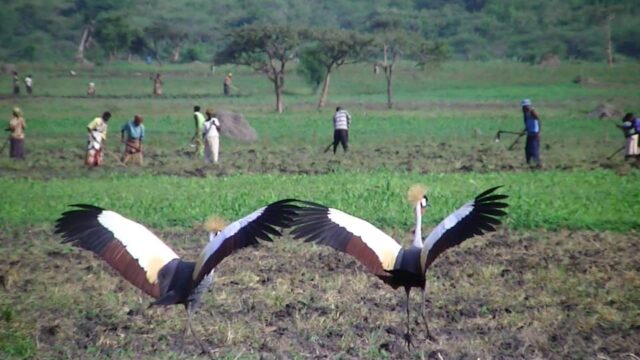
By Kelly Rwamapera
Since 2014, the population of the grey crowned crane, a species native to Rwanda and Uganda, has seen a remarkable surge, offering hope for this once-threatened bird.
However, this population boom has been accompanied by an increasing threat to their survival, particularly in the marshlands where humans come into contact with the birds in rice cultivation fields.
Intego News has established that on 1 October 2021, on the outskirts of Akagera National Park, Athanase Sibomana and his wife Delise Muhawenimana poisoned 12 grey crowned cranes in their rice field.
Resident rice farmers were shocked to see staggering birds trying to hold their last breaths while they could do nothing to help the birds regain life.
According to documents received from the Prosecution, Sibomana fled after realising that fellow farmers had found it shocking to see innocent birds fall. His wife was arrested.
“When we arrived at the crime scene, we found poisoned rice grains placed in 67 different spots, all of which were areas where these birds typically forage,” the prosecution report said.
Intego News has also uncovered another infamous incident that occurred on the evening of 15 June 2024, in Nyagatare District’s Muvumba Marshland in north-eastern Rwanda.
Ten grey crowned cranes died on the spot. The 34-year-old suspect, Jean Marie Vianney Sindikubwabo, was apprehended by witnesses who found him carrying a sack of the dead birds.
Court documents show that subsequent investigations revealed that the resident of Nyagatare had killed the birds with poisoned grains of maize and intended to sell the dead birds for meat.
Nyagatare Primary Court, in July 2024, convicted Sindikubwabo for killing the cranes and sentenced him to three years in prison, along with a fine of Rwf2 million.
Dr. Deo Ruhagazi, Assistant CEO at the Rwanda Wildlife Conservation Authority (RWCA), the organisation that lodged the case against Sindikubwabo, highlighted the growing concern:
“We’re working with rice-growing cooperatives, sensitising them on how it’s possible to live alongside the cranes without harming them,” Ruhagazi said.
According to data from the Rwanda Development Board (RDB), the grey crowned crane population has grown to 1,293 in 2024, a significant rise from just 300 in the past decade.
This increase can be attributed to various conservation efforts, including amnesty programmes between 2014 and 2017, which encouraged the return of privately held cranes to the wild.
“Crested cranes are very sensitive. If someone approaches their nesting site, they may abandon it or stop laying eggs. This is why they cannot thrive in captivity,” Dr. Ruhagazi emphasised, stressing the cranes’ need for freedom to thrive.
The Muvumba Farmers Cooperative of Nyagatare District has reported that most grey crowned cranes in the area are found in parts of the marshland that are not cultivated.
However, the RWCA is concerned that many cases of crane killings go unreported.
Dr. Ruhagazi acknowledges the issue, stating, “We’ve discovered that cranes are being killed in cold blood. Since last year, we have decided to document every case involving these birds.”
These incidents highlight the ongoing challenges of balancing agricultural practices with wildlife conservation.
While the rise in grey crowned crane numbers is a success story, it also serves as a reminder of the complex interactions between humans and wildlife.
The need for continued education, stronger enforcement of wildlife protection laws, and community engagement remains critical in ensuring the survival of these iconic birds.
As Rwanda continues to progress in its conservation efforts, it is clear that more must be done to protect the grey crowned cranes and other wildlife from human interference.
Collaboration between farmers, conservationists, and authorities is essential to ensure a sustainable future for both the people and the creatures that share Rwanda’s marshlands.













